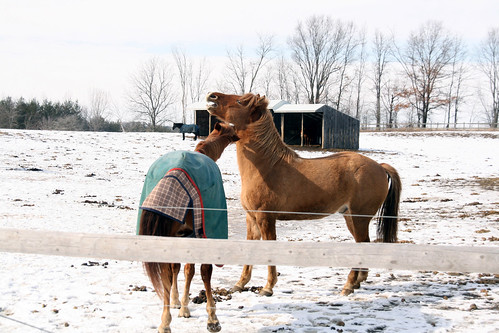Spouse and I went out to the barn where Ralphie lives today. I brought along my camera and while I was standing next to one of the fields, two horses started fighting with one another. Flush with the excitement of photo-journalism, I sprung into action and got to actually use my “burst mode” (the thing that makes that cool autowinder sound) in an effort to capture the epic battle between Quest and….well, a horse whose name I don’t know. I was feeling pretty good about getting the pictures and I was admiring my handiwork on the little LCD display on the rear of my camera when the horses actually reared up at each other. I guess I’m not quite ready for Time Magazine just yet.
I bought this circular polarizing filter a few weeks back. I was given to understand that the filter would assist me to make my skies more deeply blue. I am reasonably certain that I need to rotate the filter slightly to get the enhanced colour effect, but I can’t figure out how to determine when the effect is being applied. Am I supposed to just eyeball it through the little viewfinder and notice the difference? There must be a better way, right?


Eyeball it through the viewfinder.
^^^ What Doug said … think of it more as a tool to get your cloud-sky contrast higher. From Kodak’s Adventures in Color-Slide Photography, ISBN 0-87985-162-7:
If you look through a polarizing screen at the part of a blue sky which is a right angles to the sun and then slowly rotate the screen, you will notice that the sky gets increasingly darker as the indicator handle rotates toward the direction of the sun. If you look through the polarizing screen at oblique reflections coming from shiny, nonmetallic surfaces such as glass, wood, water, and leaves, you will find that the reflections can be greatly reduced by rotating the polarizing screen to its most effective position. This not only eliminates glare but also has the effect of increasing color saturation. Specular highlights from colored objects, such as green foliage, yellow and red leaves, and flowers, are not colored at all but white. When a polarizing screen is used to reduce or eliminate such white highlights, you can see the true color of the subject; the whole picture shows a more pleasing saturation of color and appears “cleaner.”
Theoretically, there must be something in Photoshop to make this happen, too. Being too lazy to learn it, though, I usually just play with the picture’s gamma to make things more interesting.